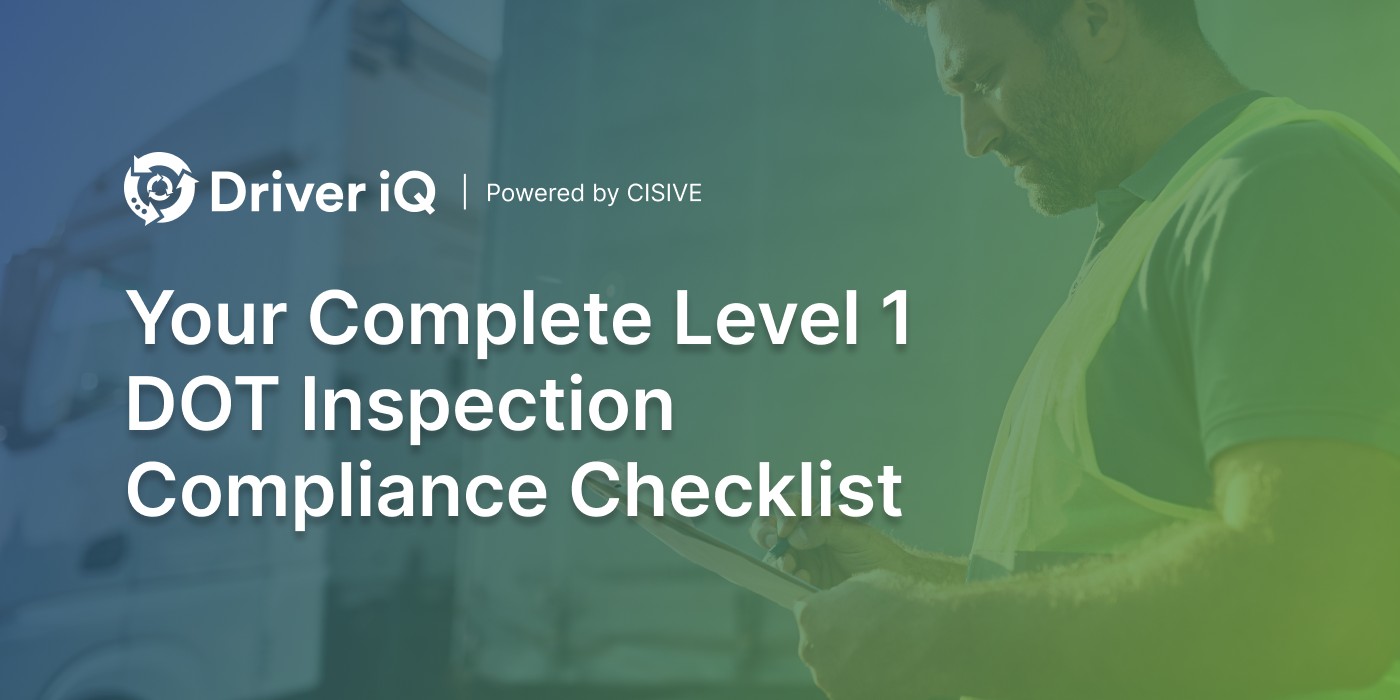
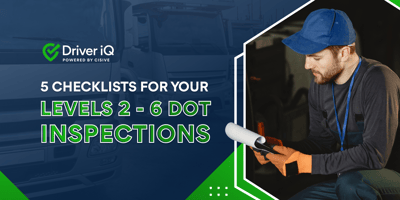
The Department of Transportation regularly conducts safety inspections on any commercial motor...

The U.S. Department of Transportation requires regular inspections of all commercial motor vehicles. Conducting these inspections helps the DOT identify unsafe truck drivers and vehicles, making the roadways safer for everyone. If your company is subject to the DOT requirements, here's what you need to know:
As part of its mission to maintain a safe, efficient transportation system, the U.S. Department of Transportation requires annual inspections of all commercial vehicles. Failing a DOT inspection has serious consequences, so it's important to be prepared.
It's tough to manage DOT compliance along with your many other responsibilities, so use this Level 1 DOT inspection checklist to increase compliance and reduce the risk of fines and other penalties.
Key TakeawaysHere's what you need to know about Level 1 DOT inspections:
|
A Level 1 DOT inspection, also known as the North American Standard Inspection, is the most thorough type of inspection for commercial vehicles.
Every motor carrier must comply with the DOT inspection requirements, but the timing of a Level 1 inspection depends on several factors. For example, if a certified inspector notices a potential safety issue, they may decide to do a Level 1 inspection instead of a Level 2 or Level 3 inspection.
Every commercial vehicle must be inspected at least once per year. All inspectors receive specialized training from the Federal Motor Carrier Safety Administration, enabling them to identify potential safety issues and make recommendations to motor carrier personnel.
Random DOT inspections prevent unsafe motor vehicles from using public roadways, so they're essential for protecting drivers, pedestrians, and cyclists. Regular inspections also ensure that motor carriers comply with all federal regulations regarding their operations.
A Level 1 inspection is the most thorough, so it takes the longest to complete—approximately 30 to 90 minutes. Inspectors use a 37-point Level One inspection checklist to ensure accuracy.
Recommended Reading: Recruiting Truck Drivers
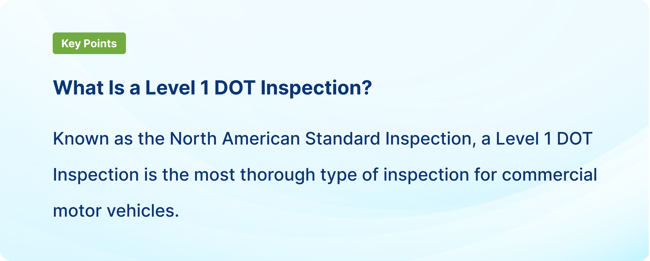
DOT doesn't have enough certified inspectors to conduct a Level 1 inspection on every vehicle. Therefore, the agency has seven additional inspection levels that aren't quite as comprehensive:
As noted previously, the Level 1 inspection is the most thorough. The inspector uses a 37-point Level 1 DOT inspection checklist to make sure a commercial motor vehicle is safe.
Level 2, also known as a walk-around driver/vehicle inspection, is a little less thorough than the Level 1 DOT inspection. The inspector examines the truck driver's license, hours of service logs, and medical examiner's certificate before checking multiple components of the commercial vehicle to ensure it's roadworthy.
Level 3 is known as a driver/credential/administrative inspection. The inspector doesn't check any of the vehicle's components, but they do examine the driver's license, medical examiner's certificate, skill performance evaluation, and several other relevant documents.
Level 4 is a special inspection. Inspectors typically examine just one item, such as a vehicle component, as part of a research study or attempt to understand a current trend in the trucking industry.
A Level 5 inspection is similar to a Level 1 inspection, except the inspector performs it without the driver present. Therefore, a Level 5 inspection is also known as a vehicle-only inspection.
Level 6 inspections are only for trucks carrying radiological materials. This type of inspection is an enhanced version of the Level 1 DOT inspection.
Also known as jurisdictional mandated commercial vehicle inspection, Level 7 is for school buses, hotel shuttles, limousines, taxis, and other commercial vehicles that aren't subject to any of the other inspection levels. In some areas, government employees and contractors are authorized to perform these inspections.
Level 8 inspections conform to the North American Standard Electronic Inspection Procedure. The inspector uses wireless technology to conduct the inspection without interacting with the driver. A Level 8 inspection typically focuses on the driver's credentials and the motor carrier's compliance with certain recordkeeping requirements.
During a Level 1 DOT inspection, a certified inspector checks the driver's credentials and inspects the commercial vehicle for signs of safety issues.
The inspection begins with a review of the driver's license, hours of duty logs, and medical examiner's certificate. An inspector may also ask to review a driver's skill performance evaluation and/or vehicle inspection reports.
After verifying the driver's credentials, a Level 1 inspector reviews the truck's major mechanical systems. This includes the exhaust system, the braking system, and the truck's steering mechanisms.
Level 1 DOT inspectors also verify that a truck's safety features are in working order. This includes turn signals, headlights, and taillights.
Recommended Reading: Understanding DOT's Preemployment Drug Testing Requirements
If one of your drivers or vehicles fails a Level 1 inspection, your company is at risk of fines and other penalties. DOT may even require you to pull the vehicle out of service, leaving you with one less truck to make deliveries.
Using a Level 1 DOT inspection checklist makes it easier to stay on top of the DOT requirements. It's also helpful for training drivers on what to expect if they encounter a Level 1 DOT inspector while employed by your company.
Checklists also have the potential to reduce errors, improve compliance, and enhance the safety of your drivers and their cargo. Here's what a Level 1 DOT inspector looks for:
After each Level 1 inspection, a certified inspector enters data into the FMCSA Safety Measurement System. The SMS helps officials keep track of violations and prioritize future enforcement efforts.
The inspector enters data regardless of whether the driver/vehicle passes or fails inspection. In fact, a clean inspection helps improve your overall safety profile with the FMCSA.
If the inspector identifies any major safety issues, they may issue an out-of-service order for the vehicle. When you receive an OOS order, you can't operate the vehicle until all safety issues have been addressed.
The inspector may also issue an OOS order for the driver. For example, if the driver has exceeded their hours-of-duty limits, the Level 1 DOT inspector may order them to stop driving immediately.
You must get permission from the DOT officer before resuming back to operating duty. If not, the driver may be subject to a $2,100 fine and the employer can face a fine of up to $16,000.
One way to improve your chances of passing this type of inspection is to train your drivers to cooperate. Drivers should always be polite and respectful, even if an inspector comes across as a bit gruff.
Drivers should also keep their required paperwork on hand and in order. For example, drivers must maintain hours of service logs to ensure they don't violate the FMCSA maximums.
When you hire a new truck driver, emphasize the importance of completing these logs and keeping them in the truck at all times. Remind drivers to have their licenses, medical examiner certificates, and other documents ready for inspection at a moment's notice.
It's also helpful to know the anatomy of each truck and keep up with the recommended maintenance schedule. Regular maintenance makes it easier to catch broken lights, worn cables, and other potential safety issues.
Finally, make sure your drivers are in the habit of conducting regular vehicle inspections. Before using a commercial vehicle, the driver should check for bald tires, broken turn signals, worn brake pads, and other hazards.
As part of this inspection, drivers should also update their hours-of-duty logs and ensure they have all required documents in the truck. Conducting a quick inspection may help drivers avoid some of the most common violations cited in the SMS.
Recommended Reading: Best DOT Compliance Services
The FMCSA conducts regular commercial vehicle inspections to prevent unsafe trucks and drivers from using public roadways. Although the inspection system has eight levels, you need to be prepared for a Level 1 inspection at all times.
One of the best ways to prepare is to use a Level 1 DOT inspection checklist to stay organized. Checklists make it easier for drivers to verify that their vehicles comply with DOT regulations.
It's also important to provide comprehensive driver training. If you're not already using inspection checklists, incorporate them into your training program for better results.
A failed Level 1 DOT inspection comes with significant penalties. If a violation is severe enough, the inspector may order your driver or your commercial vehicle out of service, making it more difficult to achieve your company's goals.
Driver iQ is a trusted partner in helping motor carriers comply with DOT requirements. We have extensive experience performing motor vehicle record checks, verifying driver credentials, and conducting background checks on drivers.
We specialize in helping motor carriers meet their obligations, so speak with an expert today to learn how we can help you improve compliance and reduce risk. level 1 dot inspection checklist.
Author: Michael Kapuschinsky
Bio: Product Manager with more than a decade of experience in the transportation industry.
Let's Connect on LinkedIn
The Department of Transportation regularly conducts safety inspections on any commercial motor...
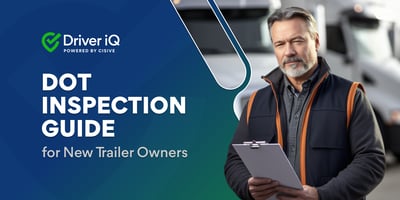
Owning and operating a new trailer can be an exciting experience. However, it’s important to...
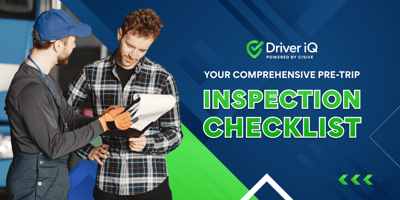
Pre-trip inspections are an everyday task for most Commercial Driver's License (CDL) drivers....